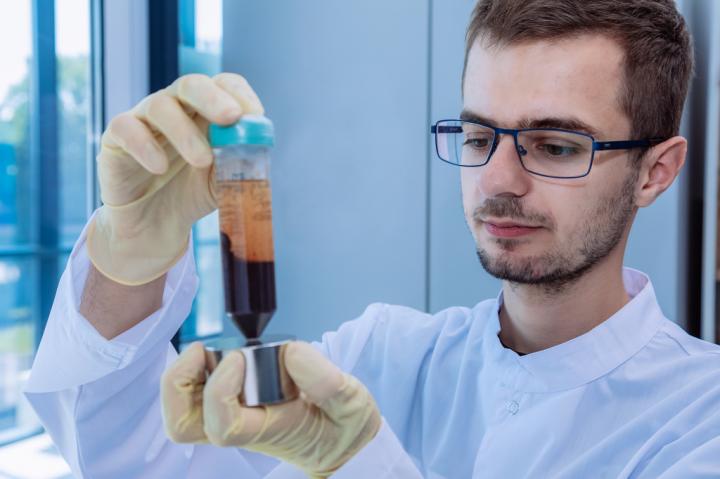
Credit: IKBFU
To achieve target delivery of drugs to cells and organs, scientists have to be able to transport the molecules of pharmaceutical substances to targets using a controllable carrier. The role of such a carrier can be played by special particles, such as lipid droplets or magnetic nanoparticles. Among the latter, the most popular are the ones based on iron oxides. Their sizes range from 1 to 100 nm, which is dozens of times smaller than animal cells, and they can be moved within a body using an external magnetic field.
However, in practice, it is quite difficult to control nanoparticles with magnets, as the magnetic field quickly becomes weaker when the distance from the magnet increases. This problem is usually solved by superconducting magnets with very high magnetic field intensity. However, they are extremely expensive and difficult to work with. A team of scientists from Immanuel Kant Baltic Federal University (Kaliningrad) and the University of Genoa (Italy) suggested a new approach to regular permanent magnets.
“To control magnetic nanoparticles, modern-day scientists often use either individual magnets or the so-called Halbach systems: classic magnet arrays that have a magnetic field only on one side. When choosing a magnet or a system, people usually pay attention only to magnetic field induction, not to its driving force. However, it’s the driving force that determines the efficiency and speed of nanoparticle delivery. Our colleagues tasked us with developing more efficient magnets to secure the delivery of nanoparticles with drugs to target organs in lab mice. The magnets had to be very small, so we were limited in the weight and size of our materials. Still, we managed to achieve improved efficiency using an array of different magnets,” said Alexander Omelyanchik, a co-author of the work, and a postgraduate student at the Laboratory of Nevel Magnetic Materials, IKBFU.
Instead of a single cylindrical magnet, the scientists suggested using a combination of permanent magnets with different shapes. To confirm the efficiency of this solution, the team used cylindrical and cubic neodymium magnets to build various symmetrical and non-symmetrical assemblies. The total surface area of magnets or their arrays did not exceed 2 cm2. After that, the team measured the values of the magnetic field and its gradient at 4 mm under the surface of the magnet. Approximately the same distance separates the surface of a mouse’s skin and its internal organs. From all magnet combinations, the team chose the ones with the strongest magnetic driving force (a physical value that is proportional to the product of magnetic field induction and its gradient).
The strongest magnetic force at a given point was registered for a combination of four magnets with the same polarity, of which two were cubic and the other two consisted of three smaller cylindrical magnets each. However, a different method of measurement showed different results. The strongest magnetic force for the area of 1 cm2 was produced by a magnet with the same structure but different polarity of one of the cylindrical components. The magnetic force of such non-symmetrical combinations in a 1 cm2 area (the size of a liver or heart or a lab mouse) was almost ten times stronger than that of regular cylindrical magnets. The team believes that the new approach could potentially apply to humans too.
“We have been studying magnetic nanoparticles in close collaboration with our colleagues from Italy, Czech Republic, Spain, Sweden, and other European countries for quite some time now. Although we are physicists, we are in constant communication with chemists, biologists, and specialists in material studies. This complementary experience helps us develop unique solutions. The interdisciplinary nature of this topic is very appealing to me, as this field of study still has many unanswered questions,” commented Alexander Omelyanchik.
###
Media Contact
Alexandra V. Titova
[email protected]
Related Journal Article
http://dx.




